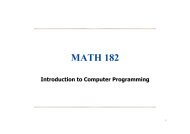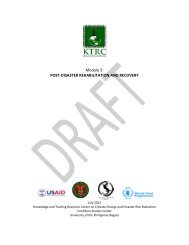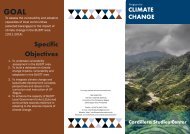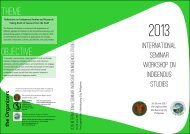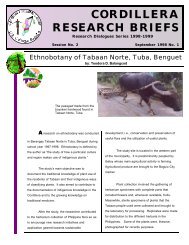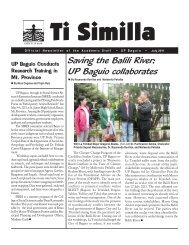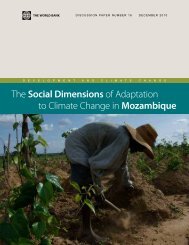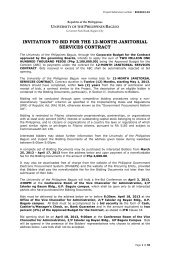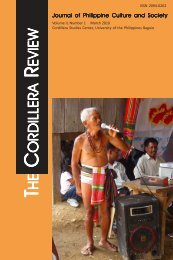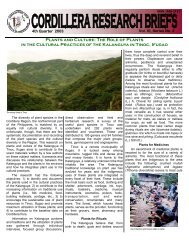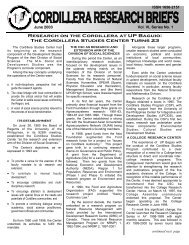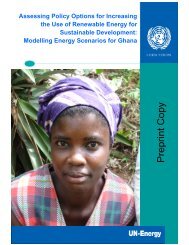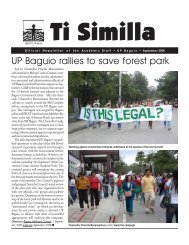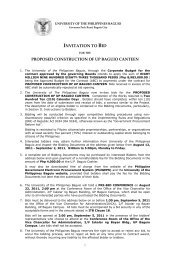Pambansang Summit sa W ambansang Summit sa W ... - UP Baguio
Pambansang Summit sa W ambansang Summit sa W ... - UP Baguio
Pambansang Summit sa W ambansang Summit sa W ... - UP Baguio
You also want an ePaper? Increase the reach of your titles
YUMPU automatically turns print PDFs into web optimized ePapers that Google loves.
ISSN 0119-6634<br />
Ti Similla<br />
O f f i c i a l N e w s l e t t e r o f t h e A c a d e m i c S t a f f • U P B a g u i o • April 2011<br />
An Interview with Dr. Purificacion Delima,<br />
Dean, College of Arts and Communication, <strong>UP</strong> <strong>Baguio</strong><br />
<strong>Pamban<strong>sa</strong>ng</strong> amban<strong>sa</strong>ng <strong>Summit</strong> <strong>Summit</strong> <strong>sa</strong> <strong>sa</strong> W WWik<br />
W ik ika ik a 20 2011: 20 1:<br />
Count Countering Count ering hegemonies<br />
hegemonies<br />
“Small languages and cultures are the first ones to be victimized”<br />
What preparations were done for the<br />
<strong>Summit</strong>?<br />
Work started in June 2010 when the<br />
call for propo<strong>sa</strong>ls was issued through various<br />
means. For example, posters, invitations<br />
to schools and other institutions<br />
were released; online promotions were<br />
created such as the PSW link in the College<br />
of Arts and Communication (CAC)<br />
site on the <strong>UP</strong> <strong>Baguio</strong> website, a Facebook<br />
homepage and an e-mail address:<br />
cac.psw2011@gmail.com. Brian our CAC<br />
clerk and a student assistant monitored<br />
communications on the gmail address.<br />
The Secretariat headed by Ria Florendo<br />
did full-blast posting of invitations. The<br />
Executive Committee manned by the<br />
College Executive Board took care of abstract<br />
propo<strong>sa</strong>ls received and the overseeing<br />
of work. These were the two committees<br />
that started the work. Just this month<br />
we created all the working committees.<br />
Thanks to those who accepted heading the<br />
committees, we now have the program<br />
committee, headed by Junley Lazaga; the<br />
workshop committee, headed by Candy<br />
Torres; the socials committee led by the<br />
CAC Socials Committee through Shine<br />
Queri, Yanyan Fajardo and Joy Abellada;<br />
the Food and Amenities Committee,<br />
headed by Rina Afable and Iday<br />
Mendigo.<br />
Alam natin kung ano ang trabahong<br />
ginagawa ng workshop, food at program<br />
committees, pero partikular ang<br />
naiatang na trabaho <strong>sa</strong> socials committee;<br />
ito ay ihanda ang programa <strong>sa</strong> welcome<br />
socials na tinawag kong “Umali<br />
Kayo: Gabi ng mga Wika at Kultura.”<br />
Ito yung event na hiningan ko kay<br />
Chancellor ng food funding support <strong>sa</strong><br />
halagang 10K. I wish to <strong>sa</strong>y that this<br />
amount will go a long way in support of<br />
the purpose of this cultural night, which<br />
is to recognize all living languages and cultures,<br />
both local and foreign ones extant<br />
in the Philippines.<br />
So far, how many have signified interest<br />
in attending?<br />
We have no count but we are optimistic<br />
about getting a large participation based<br />
on inquiries we’ve gotten and requests for<br />
formal invitations for institutional funding<br />
support. On the other hand , while<br />
we’re hopeful for a big number of participants,<br />
we’re also apprehensive that our<br />
plenary and parallel venues may be too<br />
Dr. Purificacion Delima: <strong>Summit</strong> Convenor<br />
small for everyone’s comfort. There’s this<br />
mixed feeling then.<br />
How many panels and paper presentations<br />
are now scheduled?<br />
There are 39 paper presenters on the<br />
list. These make up seven session panels:<br />
three for Wika, Edukasyon at Teknolohiya;<br />
two for Wika, Kultura at Lipunan; and<br />
two for Estado ng Wika <strong>sa</strong> Iba’t Ibang<br />
Larangan. There will be four parallel sessions<br />
in the afternoon of Day 1, April 29<br />
and three parallel sessions in the morning<br />
of Day 2, April 30.<br />
continued next page
Who are the main speakers?<br />
1) Marilou Leviste Jacob, current Executive<br />
Director of the National<br />
Commissiion on Culture and the Arts<br />
(NCCA); 2) Virgilio Almario, National<br />
Artist for Literature; 2) Rolando<br />
Tolentino, current Dean of the College<br />
of Mass Communication, <strong>UP</strong> Diliman; 3)<br />
Catherine Young, project coordinator of<br />
Summer Institute of Linguistics International,<br />
now based in Bangladesh, to be<br />
represented by Director Cslenn Stellsmith<br />
and Assistant Director John Young of SIL<br />
Philippines; 4) Lolita Delgado Fansler,<br />
President of Mangyan Heritage Center in<br />
Calapan City, Mindoro Oriental.<br />
What considerations led you to conceptualize<br />
this <strong>Summit</strong>?<br />
My training in linguistics, both theoretical<br />
and applied, has created this passion<br />
for the well-being and sustained existence<br />
of languages and cultures, especially the<br />
small ones, based on number. These are<br />
usually the weak ones too, because they<br />
are very vulnerable to hegemonies surrounding<br />
them. Small languages and cultures<br />
are the first ones to be victimized, if<br />
not eaten up by big elements in society,<br />
not only by big cultures and languages<br />
themselves, but also by political and economic<br />
power elements. These powers usually<br />
create the miserable conditions of<br />
marginalized communities, resulting in<br />
unhappiness and discontent in lives.<br />
Because of the influences of the powerful,<br />
not only locally in the Philippines but<br />
also in the global scenario, culture bearers<br />
and guardians themselves have been demotivated<br />
in promoting and sustaining<br />
their own linguistic and cultural heritage.<br />
And so we clearly see and observe today<br />
the lack of parents’ initiative and effort to<br />
transmit their native languages and cultures<br />
to the youth. This vanishing motivation<br />
for inter-generational transmission<br />
of languages and cultures is the strong factor<br />
that will likewise cause the vanishing<br />
of our indigenous languages and cultures.<br />
This is a trend that should be appalling<br />
for everyone because it means the loss of<br />
2 TI SIMILLA April 2011<br />
Interview<br />
cultural and linguistic identity in the end.<br />
What issues in language will surface in<br />
discussion, do you think?<br />
Based on the abstract propo<strong>sa</strong>l topics,<br />
these will be in focus: 1) Is it L1 or L2<br />
that is effective for learning? 2) Is English<br />
in the Philippines still a hegemonic language?<br />
3) What is the role of the national<br />
language, Filipino, in a multilingual scenario?<br />
4) Are our institutions, governmental<br />
and non-governmental, determined to<br />
pursue a multilingual scenario? What may<br />
be the forces against this pursuit? 5) Can<br />
the Philippines really be capable of foregoing<br />
its colonial language captivity after<br />
all these years of English emphasis in all<br />
Philippine societal domains? 6) What can<br />
help the pursuit of such a positive direction,<br />
emulating progressively sound<br />
economies such as China, Korea,India, not<br />
to go beyond Asian territories?<br />
Is the issue of bilingualism and early<br />
education still current?<br />
Yes, the issue remains hot. Despite the<br />
new language policy, the Mother Tongue<br />
Based Multilingual Education, (and it’s<br />
now three years old), full-blast implementation<br />
remains in limbo. Problems of<br />
teacher competency, availability and production<br />
of learning materials are huge<br />
obstacles to overcome. But always, I <strong>sa</strong>y,<br />
and to quote a cliché: if there’s a will,<br />
there’s a way. It is strong will and determination<br />
coupled with truly systematic<br />
planning and study that will spell the success<br />
of MLE. It thus requires concerted<br />
effort, mainly through the DepEd and the<br />
institutions and systems within its jurisdiction.<br />
It’s as simple as that.<br />
Do you see how the <strong>Summit</strong> will impact<br />
on policies in education?<br />
Mainly, as in all conferences and forums,<br />
the PSW 2011 forum hopes to create<br />
not only a sense of awareness of the<br />
urgency to nurture Philippine languages<br />
and cultures, but most especially to make<br />
participating individuals and institutions<br />
resolve to do something toward promoting,<br />
sustaining and enhancing their respective<br />
languages and cultures through various<br />
strategies and action plans. With a nationwide<br />
represenation in the <strong>Summit</strong>, a<br />
ripples effect is hoped to be created in the<br />
many domains of Philippine society.<br />
What other gains do you foresee?<br />
We hope that the summit will put <strong>UP</strong><br />
<strong>Baguio</strong>, especially the College of Arts and<br />
Communication, henceforth at the forefront<br />
of nurturing and enhancing indigenous<br />
languages and cultures, with the<br />
Cordillera cultures as a starting point.<br />
After the <strong>Summit</strong>, we hope to see the<br />
CAC more collaborative in its research<br />
and extension service with local and national<br />
institutions. The PSW will be the<br />
start of this goal to make <strong>UP</strong> <strong>Baguio</strong> more<br />
pro-active in its efforts to sustain<br />
marginalized languages and cultures. <br />
Opening Speeches<br />
Program<br />
Marilou Leviste Jacob: “Pagkilala <strong>sa</strong><br />
mga wika ng Pilipinas: Tungo <strong>sa</strong><br />
pagsulong ng Lahing Pamana”<br />
Catherine Young: “Pagtaya <strong>sa</strong> Estado ng<br />
mga Wika <strong>sa</strong> Pilipinas”<br />
Virgilio Almario:”Pagpapalakas ng mga<br />
wika”<br />
Rolando Tolentino: “Estado ng mga<br />
wika <strong>sa</strong> iba’t ibang larangan”<br />
Lolita Delgado Fansler: Mga wika ng<br />
Pilipinas <strong>sa</strong> senaryong global”<br />
Parallel Sessions, Papers and<br />
Presenters<br />
I. Wika, Edukasyon at Teknolohiya<br />
Novelyn Barcena: “Pagsusuri ng teacher<br />
talk <strong>sa</strong> mga interaksyong<br />
pangklasrum”<br />
Lorna Beduya: “ICT integration in
English language instruction for second year high school<br />
students”<br />
Marilyn Brioso: “Integrasyon ng computer technology <strong>sa</strong><br />
pagtuturo ng Filipino”<br />
Nestor De Guzman, Yea<strong>sa</strong> Bingcang and Mary Grace<br />
Razon: “Wika at humor: Hawak kamay tungo <strong>sa</strong> mabi<strong>sa</strong>ng<br />
pagtuturo”<br />
Elizer De los Reyes: Mainstream language and the ‘other’:<br />
Constructing the indigenous in secondary schools’ texts”<br />
Jimmy Fong: “Teaching Ibaloy as a Philippine language:<br />
Issues and challenges”<br />
Emmanuel Gonzales: “Development at evalwasyon ng i<strong>sa</strong>ng<br />
prototipong programa <strong>sa</strong> pagtuturo ng Filipino bilang<br />
banyagang wika”<br />
Eric Grande: “Multilingualism in the continuing education<br />
of health workers toward quality basic health services”<br />
Jane Lartec: “Ang pagsulat <strong>sa</strong> Filipino ng mga mag-aaral<br />
na may kapan<strong>sa</strong>nan <strong>sa</strong> pandinig”<br />
Norbert Lartec and Gemma Perey: “Kakayahang<br />
panggramatika <strong>sa</strong> Filipino ng mga mag-aaral <strong>sa</strong> University of<br />
the Cordilleras”<br />
Godfrey Montera: “Pagtataya <strong>sa</strong> mga <strong>sa</strong>loobin ng mga<br />
instructor at mag-aaral na Cebuano <strong>sa</strong> epekto ng pagtuturo ng<br />
wikang Filipino”<br />
Edna Nagtalon: “L1/MLE instruction and advocacy at the<br />
College of Teacher Education”<br />
Jeanette Onongen: “An antidote against the declining English<br />
proficiency of Filipino tertiary students”<br />
Leticia Pagkalinawan: “Mga estilo at estratehiya <strong>sa</strong> pag-aaral<br />
at pagkatuto: I<strong>sa</strong>ng mungkahing dulog <strong>sa</strong> mahu<strong>sa</strong>y na<br />
pagtuturo ng Filipino”<br />
Florinda Palma-Gil and Ria Rafael: “Filipino bilang wikang<br />
panturo ng wikang Hapon”<br />
Joey Villanueva: “Paghahawan ng mga balakid tungo <strong>sa</strong> mas<br />
kompetitibong pagkatuto ng mga dayuhang mag-aaral<br />
ng wikang Filipino: I<strong>sa</strong>ng natatanging pag-aaral”<br />
Purificacion Delima: “NMK(Naimbag nga morning,<br />
kapamilya): Ebidensya ng natural na paggamit ng wika<br />
<strong>sa</strong> multilinggwal na konteksto at impact <strong>sa</strong> pagtuturo”<br />
II. Wika, Kultura at Lipunan<br />
Ro<strong>sa</strong>lie Calpito: “Kahulugan ng mga terminong patawad<br />
<strong>sa</strong> mga diskurso ng mga maikling kuwentong Ilokano”<br />
Anna Coloma: “The emergent Tarlac variety of Kapampangan<br />
in Taralac City: A descriptive study”<br />
Nestor De Guzman: “Ang mga kulturang popular <strong>sa</strong><br />
pagpapayaman ng wikang Filipino<br />
Evangeline De la Cruz; Voltaire Oyzon and Michael Villas:<br />
<strong>Summit</strong> Program<br />
“ The acoustic properties of Waray vowels”<br />
Christopher Dofitas and Mark de Chavez: “Mga <strong>sa</strong>lik na<br />
nakakaapekto <strong>sa</strong> pagpa<strong>sa</strong> ng wikang Gaddang <strong>sa</strong><br />
nakababatang henerasyon”<br />
Wennielyn Fajilan and Rachelle Rodriguez: “Sawikaan at<br />
ang pagbabanyuhay ng wikang Filipino: Ilang tala ukol <strong>sa</strong><br />
ugnayan ng wika at kulturang popular <strong>sa</strong> ka<strong>sa</strong>lukuyan”<br />
Firth McEachern and Elizabeth Calinawagan: “Projections<br />
of language use in an urban center of Northern Luzon<br />
Philippines”<br />
Norma Mendoza: “Mga kuwentong bayan ng Kabulowen<br />
Dumagat: I<strong>sa</strong>ng linggwistika’t cultural na pagsusuri”<br />
Wilfredo Mina: “Insight into Filipino dynamics through<br />
family metaphors”<br />
Michael Villas: “Waray poetry and the language issue:<br />
A critical discourse analysis”<br />
Louward Zubiri and Kate Janagap: “Language u<strong>sa</strong>ge of 3 rd<br />
and succeeding generations of Chinese Filipinos”<br />
Purificacion Delima: “Promoting communitybased<br />
initiatives for linguistic and cultural diversity”<br />
III. Estado ng Wika <strong>sa</strong> Iba’t Ibang Larangan<br />
Severino Alviento: “Significance of language used<br />
in local legislation”<br />
Sherma Beno<strong>sa</strong>: “Ilocano orthography: issues and<br />
recommendations”<br />
Evangeline De la Cruz, Rocini Tena<strong>sa</strong>s,<br />
Regalado Tupaz, Michael Villas and Voltaire Oyzon:<br />
“The acoustic properties of Waray vowels:<br />
Towards a modern Waray orthography”<br />
Jerico Esteron: “Mula Pangasinan tungong Filipino:<br />
Pag<strong>sa</strong><strong>sa</strong>lin ng ilang mga ‘anlong’ ni Santiago Villafania”<br />
Junley Lazaga: “Pag<strong>sa</strong><strong>sa</strong>lin <strong>sa</strong> Filipino ng ilang daniw<br />
may diin <strong>sa</strong> pag<strong>sa</strong>lba’t pag<strong>sa</strong>kripisyo at panghihiram”<br />
Firth McEachern and May Alzate: “Contemporary<br />
Philippine language planning in a global context”<br />
Edna Nagtalon: “A handbook on Ilocano rhymes<br />
and jingles”<br />
Anna Christie Torres: ‘Ngangagaman bahag at si William<br />
Henry Scott: Pag<strong>sa</strong><strong>sa</strong>lin at ang diskursong Kordilyera”<br />
Mark De Chavez: “Wika <strong>sa</strong> merkado: Wikang gamit<br />
<strong>sa</strong> pabalat ng mga produkto”<br />
Jay-Ar Igno: “Filipino fonoloji: I<strong>sa</strong>ng pagsusuri<br />
<strong>sa</strong> wika ng brodkast-midya”<br />
Rommel Tabula: “Semantic change of the selected Ilocano<br />
words of Bannawag subscribers in the UNESCO Heritage<br />
City of Vigan”<br />
More information from cac.psw2011@gmail.com<br />
April 2011 TI SIMILLA 3
April Timek : Part I<br />
Air Quality in the City<br />
Air quality is measured by the levels<br />
of certain ambient air pollutants that are<br />
major environmental health hazards.<br />
These include particulate matter - total<br />
suspended particulates (TSP) and PM 10 ,<br />
carbon oxides (CO and CO 2 ), nitrogen dioxide<br />
(NO 2 ), sulfur dioxide (SO 2 ), Ozone<br />
(O 3 ), among others. The Philippine Clean<br />
Air Act of 1999 sets standards for TSP,<br />
PM 10 , CO, NO 2 and SO 2 . The connection<br />
between the deterioration of air quality<br />
and human health impacts is fairly established.<br />
From Cassidy et al. (2007):<br />
Epidemiological studies show<br />
that there is a close correlation<br />
between exposure to air pollutants<br />
and mortality and morbidity,<br />
including asthma, chronic<br />
obstructive pulmonary disease,<br />
cardiovascular disease, lower<br />
birth weights, cancer, and premature<br />
births. Furthermore, particulate<br />
matter generated from combustion<br />
processes, particularly<br />
diesel exhaust particulates, are<br />
highly toxic and often result in<br />
more exacerbated health effects.<br />
Focusing on particulate matter (PM)<br />
standards, total suspended particulates<br />
(TSP) refer to particulate matter with aerodynamic<br />
diameter between 20-50 micrometers.<br />
PM 10 , on the other hand, refers<br />
to particles with aerodynamic diameter<br />
less than 10 micrometers, which may<br />
4 TI SIMILLA April 2011<br />
Column<br />
Reclaiming <strong>Baguio</strong>’s Pristine Air<br />
and Green Environment: Would it Make Economic Sense?<br />
By Achilles Costales<br />
Table 1. Comparative standards for Air Quality for PM 10 and TSP.<br />
(In µg/m 3 )<br />
reach the upper part of the airways and<br />
the lungs. Standards on critical values of<br />
PM 10 are set for maximum allowable exposures,<br />
in micrograms per cubic meter<br />
(µg/m 3 ), on a short-term basis (24-hr<br />
mean) and long-term basis (annual mean).<br />
Long-term critical values are lower than<br />
the short-term standards. Table 1 compares<br />
the standards for particulate matter<br />
adopted by the Philippines (CAA 1999),<br />
the European Union (EU), and the UN<br />
World Health Organization (WHO). For<br />
PM 10 , both the EU and WHO standards<br />
are more stringent than those precribed<br />
in the 1999 CAA of the Philippines.<br />
The EU Directive also imposes that<br />
the number of days in which the shortterm<br />
limits are breached should not exceed<br />
35 days within a given year. In addition<br />
to its Air Quality Guideline (AQG),<br />
it also sets graduated interim targets (IT’s)<br />
for the short-term PM 10 levels, between<br />
50 to 150µg/m 3 , and for the long-term levels,<br />
between 20 and 70µg/m 3 . These targets<br />
correspond to the magnitudes of increased<br />
mortality risks associated with<br />
larger values of the IT’s. For the 24hr<br />
standard, remaining in the lowest-level<br />
target of PM 10 not exceeding<br />
150µg/m 3 implies an average increase<br />
of about 5% in short-term<br />
mortality risk over the levels associated<br />
with meeting the 24-hr AQG.<br />
For the annual standard, staying at<br />
the lowest-level target of PM 10 not<br />
exceeding 70µg/m 3 implies an aver-
Fig. 1. Annual mean TSP levels in CAR-<strong>Baguio</strong> Plaza and other EMB-<br />
DENR monitoring stations relative to the national standard, 2003-2007<br />
(In µg/m 3 )<br />
age increase of around 15% in long-term<br />
mortality risk.<br />
<strong>Baguio</strong> TSP levels<br />
Over the years, how did <strong>Baguio</strong> compare<br />
with the other cities in the Philippines<br />
in terms of air quality? The EMB-<br />
DENR National Air Quality Status Report<br />
2005-2007 showed total suspended<br />
particulates (TSP) across air quality monitoring<br />
stations in various cities in the<br />
country. Figure 1 reveals that over the<br />
years spanning 2003-2007, the CAR-<br />
<strong>Baguio</strong> station registered the highest TSP<br />
mean level (192µg/m 3 ), exceeding the national<br />
standard by a factor of 2.<br />
In recent years, the TSP measure of<br />
air quality has now been replaced by the<br />
finer particulates measure, the PM 10 , since<br />
coarser particulates could be filtered via<br />
the nose and mouth (Clean Air Initiatives<br />
for Asia, 2010).<br />
<strong>Baguio</strong> PM 10 levels<br />
Since 2007, the EMB-DENR CAR -<br />
<strong>Baguio</strong> air quality monitoring station<br />
started measuring the PM 10 levels. Table<br />
2 shows the quarterly and annual mean<br />
levels of PM 10 in <strong>Baguio</strong> from 2007 to<br />
2010.<br />
Column<br />
The quarterly entries<br />
have two quarters with<br />
missing entries. These<br />
missing entries are associated<br />
with equipment<br />
malfunction over some<br />
days within the quarter.<br />
Throughout the<br />
four-year period, the<br />
annual mean levels of<br />
PM 10 in <strong>Baguio</strong> were in<br />
violation of the national<br />
standard of 60 µg/m 3 set<br />
by the Philippines CAA<br />
of 1999. Moreover, in<br />
none of the years did the<br />
mean levels of PM 10 pass<br />
the WHO lowest interim<br />
target (IT-1) set at<br />
70µg/m 3 associated with increased longterm<br />
mortality risk by 15% relative to the<br />
AQG. Using the WHO annual mean<br />
guideline as standard, the <strong>Baguio</strong> PM 10 annual<br />
mean levels were higher by 266% to<br />
430%.<br />
On average, the PM 10 levels subside<br />
during the 3 rd Quarter. This may correspond<br />
to the rainy season and typhoon<br />
period when economic activity slows<br />
down, rainfall washes down some of the<br />
particulates, or the stronger winds blow<br />
some proportion away. Still, on a quarterly<br />
basis, there was also no period of the<br />
year where the <strong>Baguio</strong> PM 10 levels passed<br />
the national standard.<br />
On an annual basis, taking the last<br />
three years, a worsening<br />
of the PM 10 levels<br />
has been taking place.<br />
This indicates that between<br />
2008 and 2010,<br />
the air quality of<br />
<strong>Baguio</strong> had been worsening.<br />
The EMB-DENR<br />
CAR - <strong>Baguio</strong> computerized<br />
equipment<br />
records PM 10 and other ambient air pollutants<br />
at its monitoring station on real<br />
time basis. For short-term evaluations<br />
over a 24-hr period, minute-by-minute levels<br />
are captured. A <strong>sa</strong>mple period was obtained<br />
covering the days 8-11 February<br />
2011. The data are averaged on an hourly<br />
basis to obtain a picture of how the PM 10<br />
levels behave over a 24-hour period. Figure<br />
2 (next page) depicts the behavior of<br />
PM 10 levels in the <strong>Baguio</strong> Central Business<br />
District (CBD) on ordinary working days.<br />
Tracked over four days, the graph of<br />
the hourly PM 10 levels shows a strong<br />
regular pattern of peaks and troughs. The<br />
recorded levels register a mean of 67.3 µg/<br />
m 3 . This level is well within the 24-hr<br />
Philippines standard of 150µg/m 3 . Can we<br />
conclude that the air quality of <strong>Baguio</strong> is<br />
relatively acceptable? Note, however, this<br />
value is still 35% above the WHO/EU 24hr<br />
guidelines.<br />
The regular pattern of the hourly behavior<br />
of PM 10 levels in the <strong>Baguio</strong> CBD<br />
indicates that it reaches peak levels at<br />
around 06:00 and 07:00 in the morning,<br />
and another peak from 17:00 to 19:00 in<br />
the evening. Using the Philippine 24-hr<br />
150µg/m 3 guideline, the <strong>Baguio</strong> PM 10 levels<br />
regularly breach the critical value in<br />
the morning rush hour, then also breaks<br />
the 100µg/m 3 mark in the evening rush<br />
hour. Using the common WHO/EU 24hr<br />
guideline, however, citizens in the<br />
<strong>Baguio</strong> CBD are exposed daily to PM 10 levels<br />
that exceed the 50µg/m 3 critical value<br />
for almost their entire active hours, from<br />
Table 2. Quarterly and annual means of PM 10 in <strong>Baguio</strong>,<br />
2007 – 2010.<br />
April 2011 TI SIMILLA 5
mg/m 3<br />
mg/m 3<br />
250<br />
200<br />
150<br />
100<br />
50<br />
0<br />
00:00<br />
02:00<br />
04:00<br />
06:00<br />
08:00<br />
10:00<br />
12:00<br />
14:00<br />
16:00<br />
18:00<br />
20:00<br />
22:00<br />
Source: EMB-DENR CAR 2011<br />
05:00 in the morning until 20:00 in the<br />
evening. The levels abate only when the<br />
residents are already in their homes, and<br />
may not neces<strong>sa</strong>rily be enjoying the benefits<br />
of the lower air pollution in the city<br />
center. Thus, on a daily basis, an ‘averaging<br />
out’ of the actual hourly pollution levels<br />
gives somehow a false sense of security,<br />
and masks the seriousness of the levels<br />
of exposure over the span of the day<br />
when the levels of pollution impact on<br />
them the most.<br />
How ‘acceptable’ or how ‘bad’ the air<br />
quality of <strong>Baguio</strong> really is? It now becomes<br />
obvious that the assessment depends on<br />
the standard that is being adopted as the<br />
norm. The more ‘lenient’ the standard<br />
being used, the ‘better’ the air quality appears<br />
to be. This means that there would<br />
be lesser political pressure on the local and<br />
national authorities to undertake measures<br />
to curb the current air pollution levels.<br />
When the health of the citizens is at risk<br />
through exposure to the current high concentrations<br />
of ambient air pollutants, the<br />
potential risk is not removed by adopting<br />
a more ‘permissive’ standard.<br />
An independent study on the air quality<br />
of <strong>Baguio</strong> by Cassidy, et al. (2007), using<br />
the levels of concentration of finer and<br />
even more dangerous particulates (PM 2.5 ),<br />
found a similar pattern of hourly concen-<br />
6 TI SIMILLA April 2011<br />
Philippines 24-hr<br />
Guideline<br />
67.3 <strong>Baguio</strong> 4-day<br />
mean<br />
WHO/EU 24-hr<br />
AQG<br />
Fig. 2. Hourly behavior of PM 10 levels in the <strong>Baguio</strong> Central Business<br />
District, 24-hr periods, 8-11 February 2011<br />
(In µg/m 3 )<br />
Column<br />
trations of the ambient air<br />
pollutant in the <strong>Baguio</strong><br />
CBD. The mean level over<br />
a three-week period in December<br />
2004 was determined<br />
to be at 72.9µg/m 3 .<br />
The guideline set by the<br />
WHO for PM 2.5 is 10µg/<br />
m 3 . For the US Environmental<br />
Protection Agency<br />
(EPA), standard is set at<br />
15µg/m 3 . For the EU, the<br />
standard is 25µg/m 3 . In<br />
general, the standards set<br />
for PM 2.5 are more stringent<br />
than those allowable<br />
for larger particulates. The<br />
authors used the figures they obtained to<br />
compare the <strong>Baguio</strong> PM 2.5 levels with<br />
those observed in selected cities of the<br />
world that had higher mean levels than<br />
the US EPA standard. The comparison is<br />
shown in Table 3.<br />
From their findings, the authors<br />
observed that:<br />
Excluding the studies in Beijing,<br />
China, no other study observed an average<br />
ambient PM 2.5 concentration as high<br />
as the levels present in <strong>Baguio</strong> City. …<br />
Continuous ambient concentrations of<br />
the magnitude seen in <strong>Baguio</strong> are rarely<br />
seen in developed countries and are sporadically<br />
seen within developing countries,<br />
except in areas prone to elevated concentrations<br />
partially<br />
due to local topography.<br />
The combination<br />
of pollution<br />
sources and the local<br />
topography makes<br />
<strong>Baguio</strong> City’s ambient<br />
air quality worse<br />
than that seen in<br />
most locations<br />
throughout the<br />
world.<br />
The evidence at<br />
hand on the levels of<br />
ambient air pollut-<br />
Sampling Location g/m 3<br />
Sampling Location g/m<br />
Beijing, China (1999-2000) 116.0<br />
Beijing, China (2003) 93.6<br />
<strong>Baguio</strong> City, Philippines (2004) 72.9<br />
Seoul, South Korea (2001-02) 48.5<br />
Turin, Italy (2000-01) 44.9<br />
Mexico City, Mexico (1997) 38.7<br />
Guatemala City, Guatemala (1997) 37.9<br />
Los Angeles - South Coast Basin (2002-04) 24.8<br />
Barcelona, Spain (2000-01) 22.2<br />
Paris, France (2000-01) 17.8<br />
3<br />
Beijing, China (1999-2000) 116.0<br />
Beijing, China (2003) 93.6<br />
<strong>Baguio</strong> City, Philippines (2004) 72.9<br />
Seoul, South Korea (2001-02) 48.5<br />
Turin, Italy (2000-01) 44.9<br />
Mexico City, Mexico (1997) 38.7<br />
Guatemala City, Guatemala (1997) 37.9<br />
Los Angeles - South Coast Basin (2002-04) 24.8<br />
Barcelona, Spain (2000-01) 22.2<br />
Paris, France (2000-01) 17.8<br />
Source: Cassidy, et al. 2007.<br />
ants in <strong>Baguio</strong>, set against the national and<br />
international minimum standards for a<br />
healthy air quality, point to an inescapable<br />
conclusion: the current air pollution<br />
levels in <strong>Baguio</strong>, on the basis of the mean<br />
levels of PM 10 and PM 2.5 , respectively, pose<br />
a potential risk to the health of local citizens.<br />
For this alone, there exists a societal<br />
problem at hand, and the issue merits foremost<br />
policy attention, recognition, and<br />
concerted policy design and intervention<br />
to bring down the levels of the known<br />
ambient air pollutants to the level of the<br />
national, if not international standards for<br />
public health.<br />
Will the Problem be Given Proper<br />
Recognition?<br />
What chances are there that the extent<br />
of the problem would indeed be recognized?<br />
Are there any complaints from the<br />
citizens of <strong>Baguio</strong>, and a clamor for measures<br />
to bring down current air pollution<br />
levels? A real cause for concern is that the<br />
finer ambient particulates are imperceptible<br />
to the man-on-the-street. When he/<br />
she suffers respiratory or coronary ailments<br />
from these air pollutants, the connection<br />
would not neces<strong>sa</strong>rily be established.<br />
For indeed, what proportion of the<br />
local residents would likely be informed<br />
of the nature of these ambient particulates,<br />
their levels of concentration in the air they<br />
continued on page 12<br />
Table 3. Mean PM concentrations in <strong>Baguio</strong> CBD and various cities in<br />
2.5<br />
the world.
Lecture<br />
Colonialism and Gender<br />
A Report on American Colonization and Gender Relations<br />
in Central Cordillera (1900-1941)<br />
By Sabrina Nikki Ramos<br />
Within the social sciences, there is now a<br />
growing critical inquiry into the notion of<br />
diffusionism: the idea that development can<br />
only take place when there is exposure to an<br />
outside group. Accordingly, if left alone, ‘primitive’<br />
or ‘elementary’ forms of life would remain<br />
the <strong>sa</strong>me and improvement would be<br />
painstakingly slow. This in turn necessitates<br />
the apparent need to open one’s doors (or culture)<br />
to outside influence (usually in the form<br />
of colonial knowledge and influence).<br />
However, what this idea takes for<br />
granted is that not all influences from<br />
outside are neces<strong>sa</strong>rily good and<br />
would contribute to improvement.<br />
One should be careful however not<br />
to draw an equally erroneous conclusion<br />
that cultures are ‘pure’ and<br />
consist of a homogenous and unified<br />
system of ideas and values that if tampered<br />
with, would result in its demise.<br />
Rather, what is neces<strong>sa</strong>ry is a<br />
grounded and fair analysis of how cultures<br />
mediate outside influences such<br />
that agency and power relations are<br />
not taken for granted nor complacently<br />
evaded.<br />
Many are of the view that gender relations<br />
in the Cordillera are for the most part egalitarian<br />
and that the current power formations that<br />
we see at play in terms of gender could be traced<br />
back to ‘influence’ from outside, more specifically<br />
colonial influence from the Americans.<br />
The question then that we are faced with is<br />
this, are we correct to interpret gender relations<br />
in Cordillera in this light? This is precisely<br />
what Dr. Raymundo Rovillos, the Dean<br />
of the College of the Social Sciences attempted<br />
to address last February 18, 2011 when he delivered<br />
a talk that inquired into the effects of<br />
American colonialism on gender relations in<br />
the Central Cordillera. Employing archival<br />
research as a method, the study explored the<br />
role of education and mission in influencing<br />
gender relations in terms of gender ideology,<br />
gender division of labor and sexuality, com-<br />
paring gender practices prior to and during the<br />
colonial regime.<br />
It was observed that from 1900-1905, the<br />
gender division of labor in Ifugao was supposedly<br />
based on the capabilities that were deemed<br />
‘natural’ to men and women. Thus, men were<br />
given the hardest work such as rice field construction,<br />
blacksmithing and wood gathering.<br />
Women on the other hand were in charge of<br />
basket weaving, planting rice and caring for<br />
the growing rice. Interestingly, one can see that<br />
even if the women were given relatively lighter<br />
load, they in fact did most of the work as can<br />
be seen in the division of labor when it comes<br />
to rice farming. It is worth noting however,<br />
that there were some tasks that both men and<br />
women contributed to such as spading fields,<br />
harvesting, carrying rice, cooking and child caring/rearing.<br />
This then indicates that in terms of gender<br />
ideology it is noticeable that indigenous culture<br />
is one in which women have always had a<br />
measure of equality with men. This is especially<br />
true as can be seen from the examples<br />
above as both men and women contributed to<br />
work outside and inside the home. Since it<br />
was the men who did the difficult work, it was<br />
but fair that women compen<strong>sa</strong>te in doing more<br />
work than them. Thus, there seems to be an<br />
equal recognition of the importance of both<br />
Missionary teaching reified<br />
gender stereotypes<br />
men and women’s contribution. Women’s<br />
sexuality however can be seen to be inextricably<br />
related to their role as child-bearers, for<br />
the reproduction of the clan/kinship. In the<br />
<strong>sa</strong>me way that they were in charge of caring<br />
for children, they were also tasked with caring<br />
for and planting rice, thus exhibiting their ‘natural’<br />
affinity with nurturing tasks.<br />
However, with the onset of the colonial<br />
regime from 1905 to 1941, there were stark<br />
differences that took place. In line<br />
with the framework of benevolent<br />
assimilation, the colonial regime<br />
gave particular importance to educating<br />
the Igorots. It was imperative<br />
that the culture and customs of<br />
the Igorots be studied with great care<br />
in order to facilitate better governance.<br />
Moreover, the general thrust<br />
of education can be characterized to<br />
be a simple form of industrial training,<br />
equivalent to what we now<br />
know as vocational courses. Igorots<br />
can be educated to be better carpenters,<br />
better gardeners and farmers:<br />
they can be the best that they can<br />
in the realm of manual labor, but they should<br />
not traverse this sphere as doing so would entail<br />
departing widely from their habitual course<br />
of life. Of course one should not forget that<br />
knowledge of a cultivated (colonial) language<br />
is also neces<strong>sa</strong>ry “to enable them to deal advantageously<br />
with the civilized inhabitants by<br />
whom they are surrounded.”<br />
All of this implies that the colonial regime<br />
looked at the Igorot people as incapable of<br />
development when left alone in their natural<br />
surroundings. The <strong>sa</strong>me is true even with Christian<br />
missions as these served as an effective colonial<br />
instrument.<br />
As can be seen in the quote above, the<br />
Igorot people were seen to have a potential for<br />
development, but great care was <strong>sa</strong>id to be<br />
exercised in identifying those who have superior<br />
intelligence and capacity for leadership.<br />
continued on page 12<br />
April 2011 TI SIMILLA 7
The Department of<br />
Biology, in cooperation with<br />
the Lecture Series Committee<br />
of the College of Science,<br />
conducted a seminarworkshop<br />
entitled “Model<br />
Organisms for Biological and<br />
Biomedical Researches” on<br />
March 7, 2011. Aimed at<br />
encouraging colleagues in the<br />
academe to further their<br />
research activities, the<br />
Department chose the<br />
workshop topic as many<br />
biological researches involve<br />
the use of model organisms<br />
to evaluate, validate, and even<br />
to establish scientific<br />
concepts.<br />
The value of model<br />
organisms in scientific researches was<br />
highlighted by Dr. Paul Medina, a<br />
recipient of the Balik-Scientist Program<br />
of the Department of Science and<br />
Technology (DOST). As Medina<br />
mentioned in his two-part lecture, a model<br />
organism is a non-human species that is<br />
extensively studied to understand<br />
particular biological phenomena, with the<br />
expectation that discoveries made in the<br />
model organism will provide insight into<br />
the workings of other organisms. He<br />
underscored that a model organism is an<br />
alternative to using human subjects when<br />
the nature of the experiment makes it<br />
impractical or less ethical to do so.<br />
In his lecture, Dr. Medina shared his<br />
experiences and knowledge in handling<br />
some of the commonly used model<br />
organisms. Such include Escherichia coli<br />
(bacterium), Saccharomyces cerevisiae<br />
(yeast), Ceanorhabditis elegans (nematode),<br />
Mus musculus (mouse), Daphnia (water<br />
flea), and Drosophila melanogaster (fruit<br />
fly).<br />
8 TI SIMILLA April 2011<br />
Lecture<br />
Model organisms as tools<br />
in biological research<br />
By Karen Ballada and Deemson Mones<br />
Daphnia (water flea)<br />
E. coli, a gram negative bacterium, is<br />
perhaps the most well studied organism.<br />
While it is a common enteric bacterium,<br />
most laboratory E. coli have lost their<br />
ability to thrive in the intestines. E. coli<br />
DNA material consists of a single<br />
bacterial “chromosome” and multiple<br />
plasmids. E.coli is commonly used in<br />
recombinant DNA technology. Yeast, on<br />
the other hand, is another example of a<br />
microorganism often used as a model<br />
organism. It is a single, free-living cell,<br />
only 3 microns in diameter (4,000 of them<br />
lined up would measure an inch). It<br />
reproduces by budding and doubles every<br />
90 minutes, has 12 million base pairs of<br />
DNA, and has 6,000 genes, of which at<br />
least 31 percent have human equivalents.<br />
Hybridized yeast strains are being utilized<br />
in researches. These properties of the<br />
above-mentioned organisms make them<br />
good models to study bacterial and yeast<br />
transformations associated with biological<br />
phenomena.<br />
Studies contribute to medical<br />
research on human diseases<br />
Another model<br />
discussed in Dr.<br />
Medina’s lecture is<br />
the C. elegans, a freeliving<br />
(not parasitic)<br />
nematode living in<br />
soil and feeding on<br />
bacteria that thrive<br />
on decaying vegetal<br />
matter. N2 strain (a<br />
hybrid) is used in<br />
research and has<br />
been a model<br />
organism since 1974.<br />
It is the first<br />
organism whose<br />
genome was<br />
completely<br />
sequenced. C. elegans<br />
genome size is<br />
relatively small (9.7 x 10 7 base pairs or 97<br />
Megabases) consisting of 5 pairs of<br />
autosomes and a pair sex chromosome.<br />
About 35% of C. elegans genes have<br />
human homologs and human genes<br />
replace their C. elegans homologs when<br />
introduced into C. elegans. Such<br />
characteristics make C. elegans a perfect<br />
model for researches and has been<br />
employed in studies such as in autism,<br />
drug testing, kidney diseases, aging,<br />
circadian rhythm clock, herbal effects,<br />
and drug discoveries.<br />
Daphnia (water flea), on the other<br />
hand, is an organism used as fish food. It<br />
is also currently utilized in bioas<strong>sa</strong>y of<br />
chemicals in freshwaters, such as<br />
pollutants and toxins (an ecotoxicological<br />
indicator). Its high fecundity makes it the<br />
standard in toxicological testing of<br />
freshwater. So far, there are over 100<br />
species of water flea but the most studied<br />
are Daphnia pulex and Daphnia magna<br />
species. Unfortunately, Daphnia is not<br />
naturally found in the Philippines, though
a smaller close relative – the Moina - is<br />
found locally. As per record, Daphnia is<br />
the first crustacean to have its genome<br />
sequenced and is the animal with the most<br />
genes numbering to 31,000 compared to<br />
humans having only 23,000. Daphnia’s<br />
high gene number is largely due to its<br />
genes multiplying at a higher rate than<br />
other species. This occurs at about a threefold<br />
rate higher than other invertebrates,<br />
30% greater than humans. Dr. Medina<br />
mentioned that more than one-third of<br />
Daphnia’s genes are undocumented in any<br />
other organism. In other words, they are<br />
completely new to science. Of all<br />
sequenced invertebrate genomes so far,<br />
Daphnia shares the most genes with<br />
humans. Due to Daphnia’s genetic wealth,<br />
it is emerging as a model organism for a<br />
new field of science - Environmental<br />
Genomics. This field endeavors to<br />
understand how the environment and<br />
genes interact. Since the majority of<br />
duplicated and unknown genes are<br />
sensitive to environmental conditions,<br />
their accumulation in the genome could<br />
account for Daphnia’s flexible responses<br />
to environmental change.<br />
Mus musculus (laboratory mouse) is<br />
another perpetual model organism used<br />
in research. Its genetic and physiological<br />
similarities to humans allows for the<br />
generation of disease and treatment<br />
Daphnia is central to a new field, environmental genomics<br />
models. Its<br />
entire genome<br />
sequenced<br />
allows for the<br />
generation of<br />
specific<br />
m u t a n t<br />
lineages and<br />
reverse<br />
genetics<br />
studies.<br />
Genetically,<br />
the lab mouse<br />
has 40 chromosomes<br />
with three<br />
billion bases.<br />
It is the<br />
Lecture<br />
Drosophila (fruit fly)<br />
organism that is the most genetically<br />
identical to humans among model<br />
organisms. Currently, there are 426 major<br />
inbred strains available and a significant<br />
gene functional studies involves gene<br />
knockouts. A knockout mouse is a<br />
genetically engineered mouse in which one<br />
or more genes have been turned off<br />
through a targeted mutation. By causing<br />
a specific gene to be inactive in the mouse,<br />
and observing any differences from<br />
normal behavior or condition, researchers<br />
can infer its probable function. Currently<br />
used mouse models for human disease are<br />
for Alzheimer’s disease, Down syndrome,<br />
cystic fibrosis, cancer, glaucoma,<br />
types 1 and 2 diabetes, epilepsy,<br />
heart disease, muscular dystrophy,<br />
and many more. Unfortunately,<br />
use of lab mice draws negative<br />
attention from animal rights<br />
activists (i.e. PETA) and is<br />
considered immoral in some social<br />
circles.<br />
Drosophila (fruit fly) is<br />
considered an awesome research<br />
tool that can be used to investigate<br />
biological and biomedical<br />
questions. This is due to its small<br />
size (~ 4mm), very fecund (~ 50<br />
eggs/day/female), with short<br />
generation time (14 days), a large<br />
number of visible markers, a small<br />
number of chromosomes (4),<br />
amenable to various molecular<br />
manipulations, and 75% of human<br />
disease genes have counterparts in<br />
Drosophila. Diverse research areas using<br />
flies include studies on developmental<br />
processes, genetic mechanisms,<br />
neurodegenerative disease, aging,<br />
metabolic disorders, alcoholism and other<br />
addictions, cancer, heart disease, and<br />
others.<br />
During the practical sessions which<br />
followed immediately after the lecture, the<br />
junior faculty members of the department<br />
assisted Dr. Medina in giving<br />
demonstrations on handling the model<br />
organisms mentioned above. Freda Wong<br />
demonstrated the proper techniques<br />
employed in performing intraperitoneal<br />
injection, retroorbital bleeding, and<br />
dissection of mice. Noreen Follosco, on<br />
the other hand, demonstrated techniques<br />
in the preparation and maintenance of<br />
Drosophila cultures. Moreover, she<br />
demonstrated a technique in isolating<br />
polytene chromosomes. Jaime Cañedo<br />
also demonstrated the morphology and<br />
biology of Daphnia as well as the<br />
maintenance of Daphnia culture. Dr.<br />
Medina himself showed actual cultures of<br />
C. elegans and discussed how to maintain<br />
the stock culture. He also took the chance<br />
to teach the participants simple lab<br />
techniques such as determining a gram<br />
negative or gram positive bacteria using<br />
sodium hydroxide solution instead of<br />
employing the conventional gram staining<br />
method.<br />
April 2011 TI SIMILLA 9
What the team<br />
brought home<br />
from I<strong>sa</strong>bela<br />
By Jennifer Inovero<br />
The 2011 National State Colleges and Universities<br />
Athletic Association (SCUAA) was<br />
held on February 21-26, 2011 at the Gov.<br />
Melanio Singson Sports Complex, Alibagu,<br />
Ilagan, I<strong>sa</strong>bela. This was participated in by athletes<br />
from regional selections all over the country—<br />
Region I (Ilocos region), Region II<br />
(Cagayan Valley), Region III (Central Luzon),<br />
Region IV (Southern Tagalog), Region V (Bicol<br />
region), Region VI (Western Vi<strong>sa</strong>yas), Region<br />
VII (Central Vi<strong>sa</strong>yas), Region VIII (Eastern<br />
Vi<strong>sa</strong>yas), Region IX (Zamboanga Peninsula),<br />
Region X (Northern Mindanao), Region XI<br />
(Autonomous Region in Muslim Mindanao),<br />
Region XII (SOCCSKARGEN), the National<br />
Capital Region, Cordillera Administrative<br />
Region (CAR) and CARAGA region, ‘the land<br />
of the brave and the fearless’. The delegates<br />
were billeted in various public schools in<br />
I<strong>sa</strong>bela, where a warm welcome and superior<br />
hospitality from the provincial government<br />
and the people of I<strong>sa</strong>bela was felt by the participants.<br />
The <strong>UP</strong>B women’s varsity basketball team<br />
earned the right to represent CAR in the <strong>sa</strong>id<br />
meet after emerging as champions in the<br />
CARASUC eliminations held in Lamut,<br />
Ifugao two weeks earlier.We left <strong>Baguio</strong> on Sunday,<br />
February 20, via Ambuklao road and arrived<br />
in Ilagan, I<strong>sa</strong>bela at 5:00 pm. We had<br />
lunch at Solano, Nueva Vizcaya, halfway to<br />
our destination. After travelling for almost 8<br />
hours, we went straight to Alibagu to see the<br />
venue of the games and then we proceeded to<br />
Gamu Central School where all CAR delegates<br />
were billeted. The team had three ‘new’ teammates<br />
from Mountain Province State Polytechnic<br />
College (MPSPC), the only selected players<br />
from the seven participating schools in the<br />
CARASUC. Our first night in I<strong>sa</strong>bela was<br />
spent mostly for rest and a little ‘get to know<br />
10 TI SIMILLA April 2011<br />
Report<br />
each other’ since everybody<br />
was tired and we<br />
had to be up early the following morning for<br />
the opening parade.<br />
Day 1, February 21, Monday: The<br />
team was ready at six. We decided to go to the<br />
venue ahead of the others, as we had to meet<br />
with Prof. Florendo who just arrived in I<strong>sa</strong>bela<br />
a few hours earlier, bringing with him our<br />
CAR uniforms from <strong>Baguio</strong>. Assembly was<br />
at the Ilagan Municipal hall, with the opening<br />
parade starting a few minutes past 8. All delegates<br />
wore their colorful regional colors in<br />
jogging pants, t-shirts and jackets, displaying a<br />
festive morning mood for I<strong>sa</strong>bela. The delegates<br />
from each region marched to the sports<br />
complex (just a stone’s throw away) and took<br />
turns in being presented to the guests and the<br />
people of I<strong>sa</strong>bela. The opening program ended<br />
shortly after 12 noon and games immediately<br />
followed.<br />
As I tried to get hold of the schedule for<br />
basketball women, I was very surprised (and<br />
at the <strong>sa</strong>me time di<strong>sa</strong>ppointed) to know that<br />
CAR was not included in the bracketing (earlier<br />
made in SCUAA Manila office) and so we<br />
were not in the schedule of games. I inquired<br />
about this with coaches from Region III, NCR<br />
and Region IV, the tournament manager and<br />
the tournament head. With the CAR representative<br />
to the SCUAA finally talking to the<br />
tournament head and after several hours of discussions<br />
and arguments, we were finally assigned<br />
under Bracket B since teams under<br />
Bracket A were already playing at the time the<br />
‘new’ schedule was made. There were 9 entries<br />
for basketball women: two (2) brackets<br />
for a single round robin elimination type.<br />
Bracket A entries were Regions II, V, VI and<br />
NCR while Bracket B entries were Regions I,<br />
III, IV, VII and CAR. After a very long day<br />
After shooting at Gamu stadium<br />
spent under the scorching heat of the I<strong>sa</strong>bela<br />
sun, most of us had big headaches. We had<br />
dinner before going back to our quarters for a<br />
well deserved rest and good night’s sleep.<br />
Day 2, February 22, Tuesday: Game 1:<br />
CAR vs Region VII (Central Vi<strong>sa</strong>yas). The<br />
team had to be up for an early morning jog<br />
around the oval, coupled with our usual<br />
strengthening exercises (100 push-ups and 250<br />
crunches). After warm up, we went straight<br />
to Gamu stadium (about 200 meters from our<br />
quarters) for shooting drills and review of plays<br />
with MPSPC players (this was the first time<br />
that the team practiced with them). Late<br />
brunch followed. After some rest and refreshing<br />
baths, we were already at the venue before<br />
game time.<br />
However, our opponents arrived one and<br />
a half hours late, having played their first game<br />
earlier in the morning. In sports, there is such<br />
a thing called ‘defaulting time’ and if rules were<br />
to be followed strictly, we should have won<br />
our first game by forfeiture. There was even a<br />
little argument with the tournament manager<br />
because he even blamed us for ‘squeezing in’ on<br />
the schedule of games. He approached me in a<br />
not-so-polite manner and so I reasoned out his<br />
‘irrational’ arguments. In the end, he apologized<br />
and the game finally started two hours<br />
later. Losing momentum and with the team<br />
shooting only 36% field goals, 53% free throws,<br />
and committing 28 turnovers, Region VII won<br />
the game at 72-87 as the final score.<br />
With our first loss, we went back to our<br />
quarters in Gamu with a not-so-heavy heart<br />
because we knew that we played good basketball<br />
and fought as a team despite the players’<br />
‘first game jitters’. Later that night, we had an<br />
assessment of our game. Our field goal per-
Warm up<br />
centage was our first game’s weakness. Another<br />
session of the ‘in between’ game was<br />
played again that night for relaxation and<br />
‘bonding time’ before retiring.<br />
Day 3, February 23, Wednesday: Game<br />
2, CAR vs Region IV (Southern Tagalog). After<br />
the routine cardio and strengthening workout,<br />
the team completed extra shooting drills,<br />
hoping to improve our field goal percentage.<br />
From the Ilagan sports complex, games for<br />
basketball women were moved to the Roxas<br />
gym, a 30-45 minute jeepney ride from Gamu.<br />
Our game, however, started at 7:00pm, three<br />
hours earlier than scheduled. The game was<br />
slow at the start, with both teams having low<br />
scores after three quarters. Every ball possession<br />
for CAR, especially when Perucho drove<br />
down to our frontcourt, everybody in the<br />
crowd loudly cheered for the team. Indeed<br />
Perucho played the game of her life, converting<br />
shots from anywhere inside the court with<br />
whatever ‘magical’ move she knows so well.<br />
I have never coached a game like this before<br />
and I have never felt all these goose bumps all<br />
over my body while coaching in the sidelines.<br />
If the <strong>UP</strong> <strong>Baguio</strong> crowd was there, I am sure<br />
that they will be very, very proud of how the<br />
team played.<br />
If heart rate monitors were attached to each<br />
one of us, the tachycardia could have put us<br />
on the verge of ‘cardiac arrest’. We could have<br />
really won this game had we made even just<br />
one shot from the free throw line. Region<br />
IV’s pregnant assistant coach even jokingly<br />
mused that she almost gave birth with the<br />
game’s twists of turnovers. The game finally<br />
ended at 9:40 pm, with 82-81 as the final score.<br />
After some exchange of handshakes, Region<br />
IV players and their coaches even requested<br />
for a friendly ‘picture taking’ with Perucho,<br />
their ‘idol’ and with the rest of the team.<br />
Report<br />
Everybody was silent during<br />
the first few minutes of our jeepney<br />
ride back to our quarters. However,<br />
it did not take the team long<br />
enough to laugh together again and<br />
momentarily forget what happened<br />
earlier in the game. We arrived<br />
in Gamu at 10:30 pm for a<br />
quick dinner, quick shower and a<br />
quick/short assessment of our<br />
game before everybody was lulled<br />
to sleep by tiredness and ‘heavy<br />
hearts’. Honestly not knowing exactly<br />
how and what to feel that night, I told my<br />
players straight from the heart that even if we<br />
did not win this game, I still cannot feel that we<br />
lost earlier. I am very proud to <strong>sa</strong>y that the<br />
team gained a more essential value and fact of<br />
life— that is, respect—from the crowd inside<br />
the gym, because of their skills and attitude.<br />
The team had definitely won each of the hearts<br />
of the people of I<strong>sa</strong>bela inside the Roxas gym,<br />
even the hearts of our opponents and their<br />
coaches. We still had two games to be played<br />
the following day, versus Region III and Region<br />
I.<br />
Day 4, February 24, Thursday: Game 3,<br />
CAR versus Region III, 7:00 am. With only a<br />
few hours of sleep, the team still managed to<br />
finish their push-ups and crunches before leaving<br />
quarters for our third game. Breakfast was<br />
at five, with most players still very sleepy and<br />
tired from the previous night’s game. Playing<br />
again at a delayed game schedule under a hot<br />
morning sun, Region III got the better off the<br />
team, finishing the game with a 13-point advantage,<br />
57-70 as the final score. This game was<br />
even made more dramatic when I was slapped<br />
with my first ever technical foul in my 6 years<br />
of coaching. Bad officiating (since our first game)<br />
should have no room for games like<br />
these, especially when your players<br />
are working very hard to win a<br />
game. Who would not complain<br />
about numerous ‘inconsistencies’<br />
and ‘failures’ as— ‘no official ball’<br />
policy, ‘no defaulting time’ policy,<br />
there were no ground rules discussed,<br />
tournament manager doing<br />
a walk out during the coaches’ meeting,<br />
no licensed referees officiating<br />
the games, table officials who are obviously<br />
not familiar with basketball<br />
hand signals for player numbers and<br />
arrogant table officials and tournament manager?<br />
These should not be repeated again as a<br />
sign of respect to the game of basketball, the<br />
game that we all love.<br />
The team played their last game (at a delayed<br />
time schedule again as usual) still with a<br />
big heart but obviously with tired bodies.<br />
However, they still managed to put up another<br />
gallant fight, with two key players sidelined<br />
with injuries even before overtime.<br />
Ando, who rarely suffers from an injury,<br />
landed on the wrong foot after an attempt at<br />
the basket, getting a sprained left ankle in crucial<br />
time. Perucho, who ran after an opponent<br />
speeding for a fast break was charged with<br />
a blocking foul, instead of a very obvious offensive<br />
foul from that player from Region I.<br />
To avoid a bad fall, Perucho reacted instinctively,<br />
‘flying’ and falling on the floor with<br />
her left arm protecting her body, which caused<br />
her left wrist to swell due to hard impact. We<br />
brought her to a nearby hospital for x-ray after<br />
the game and she was on medication and<br />
arm sling for more than a week. Luckily, there<br />
was no fracture or dislocation in her arm. We<br />
could have won this game also if only we had<br />
converted a bonus free throw. We lost the<br />
game by three points, the final score was at<br />
88-91.<br />
As coach, I am still proud of my players<br />
even if we brought home a 0-4 win-loss card.<br />
They are a very young and inexperienced team.<br />
But they play with a very big heart each time<br />
they face their much bigger and more experienced<br />
opponents, while trying to live up to<br />
be true Lady (Fighting) Maroons representing<br />
not just <strong>UP</strong>, but CAR as a whole. <br />
Zone defense: Game versus Region III<br />
April 2011 TI SIMILLA 11
Reclaiming <strong>Baguio</strong>, from page 6<br />
breathe in their most active time of the day, and by how much<br />
these levels exceed the accepted health standards? As long-time<br />
residents have become accustomed to the gradual worsening of<br />
the air quality of the city, the incremental changes might hardly<br />
be noticeable, and the current conditions are perceived as ‘normal’.<br />
It would take an outsider, or a new arrival, to ‘spot the big<br />
difference’. Yet an outsider who makes a loud noise about the<br />
air quality in <strong>Baguio</strong>, and displeases the local authorities, might<br />
be declared persona non grata.<br />
It is also probable that local authorities, well-meaning as they<br />
would be, might not themselves be informed of the gravity of<br />
the situation, and are convinced that the measures they are undertaking<br />
now to control the air pollution levels are quite sufficient.<br />
There are significant economic and social costs to the city<br />
and to its residents if the hazardous ambient air pollutants are<br />
not brought down. The mirror image of this is that there will be<br />
economic and social benefits to the city and to the local citizens,<br />
and even to visitors, if the air is transformed to become much<br />
cleaner and the environment becomes greener. What would it<br />
take to do so? Designing and implementing realistic measures to<br />
approach that cleaner air and greener environment will certainly<br />
entail costs – ‘there is no such thing as a free lunch.’ What feasible<br />
options are out there but might have not yet been thought of?<br />
Part 2 in May Ti Similla<br />
OFFICE OF PUBLIC AFFAIRS<br />
<strong>UP</strong> BAGUIO<br />
2600 BAGUIO CITY, PHILIPPINES<br />
ENTERED AS SECOND CLASS MAIL AT THE <strong>Baguio</strong> City Central Post<br />
Office, Upper Session Road, <strong>Baguio</strong> City WITH PERMIT NO. CAR-08.<br />
Report<br />
Colonialism and Gender, from page 7<br />
However, all is naught if they are not educated in superior conditions<br />
for it is only then that their higher faculties could be cultivated. Needless<br />
to <strong>sa</strong>y, this could only be done by religious evangelization.<br />
The missions were also replete with gender ideology as the education<br />
of girls was strictly guided and supervised for the purpose of training<br />
them to become Christian wives and for them to play a role in<br />
developing model Christian families. Accordingly, by doing so the girls<br />
could exercise their influence on their fellow Igorots. In addition, education<br />
of boys and girls was starkly different. Whereas boys were trained<br />
for local leadership or more generally trained for engagement in the<br />
public sphere, women were educated to be protectors of the private<br />
sphere: caring for the home and housework.<br />
Rovillos highlights how these missions were influenced by eugenics<br />
in their aim to produce a new generation of civilized individuals and<br />
this could only be done when educated Igorot men were united with<br />
educated Christian Igorot women. Women especially played a key role<br />
as they identified women to be the protectors of tradition compared to<br />
men. Thus, if they were able to train and educate the Igorot women,<br />
they had “won half the battle” of producing a civilized society.<br />
It is worth noting however that this task proved difficult as they<br />
were unable to get as many girls as they would have liked as the parents<br />
were reluctant to allow their children, especially the girls, to be educated<br />
in mission schools. Since women did most of the work, to allow<br />
the girls to study then was to rid the parents of much needed help. The<br />
effect of education on men and women was found to be skewed as men<br />
were more literate, were able to attain a more superior education and<br />
were more engaged in professional service compared to women.<br />
Rovillos also brings to light the fact that American colonialism introduced<br />
a gender ideology based on notions of a middle class, Christian<br />
family and that missionary effort and education had the greatest impact<br />
in the area of sexuality. Moreover, gender stereotypes on gender division<br />
of labour were introduced especially among the educated, but had<br />
little impact on the rest of the population.<br />
Ti Similla ISSN 0119-6634<br />
Published by the University of the Philippines <strong>Baguio</strong><br />
through the Office of Public Affairs<br />
E-mail: opa@upb.edu.ph<br />
<strong>UP</strong> <strong>Baguio</strong> website: www.upb.edu.ph<br />
VICTORIA RICO COSTINA, Editor<br />
GRACE SUBIDO, JIMMY FONG, RUTH TINDAAN, Associate Editors<br />
KAREN BALLADA, JENNIFER INOVERO, FARA MANUEL,<br />
DEEMSON MONES, BHAZEL PELICANO, ERLINDA PALAGANAS,<br />
SHEKINAH QUERI, PHOEBE RAMOS, MARIE CHRIS RAMOYA,<br />
LETICIA TOLENTINO, Staff Writers<br />
FREDERICK PEDREGOSA, Production<br />
The views and opinions expressed in TI SIMILLA do not neces<strong>sa</strong>rily reflect the collective<br />
stand of the academic staff or the official position of <strong>UP</strong> <strong>Baguio</strong>.



